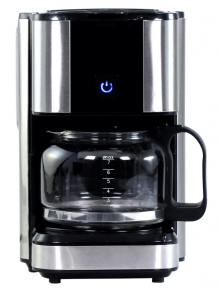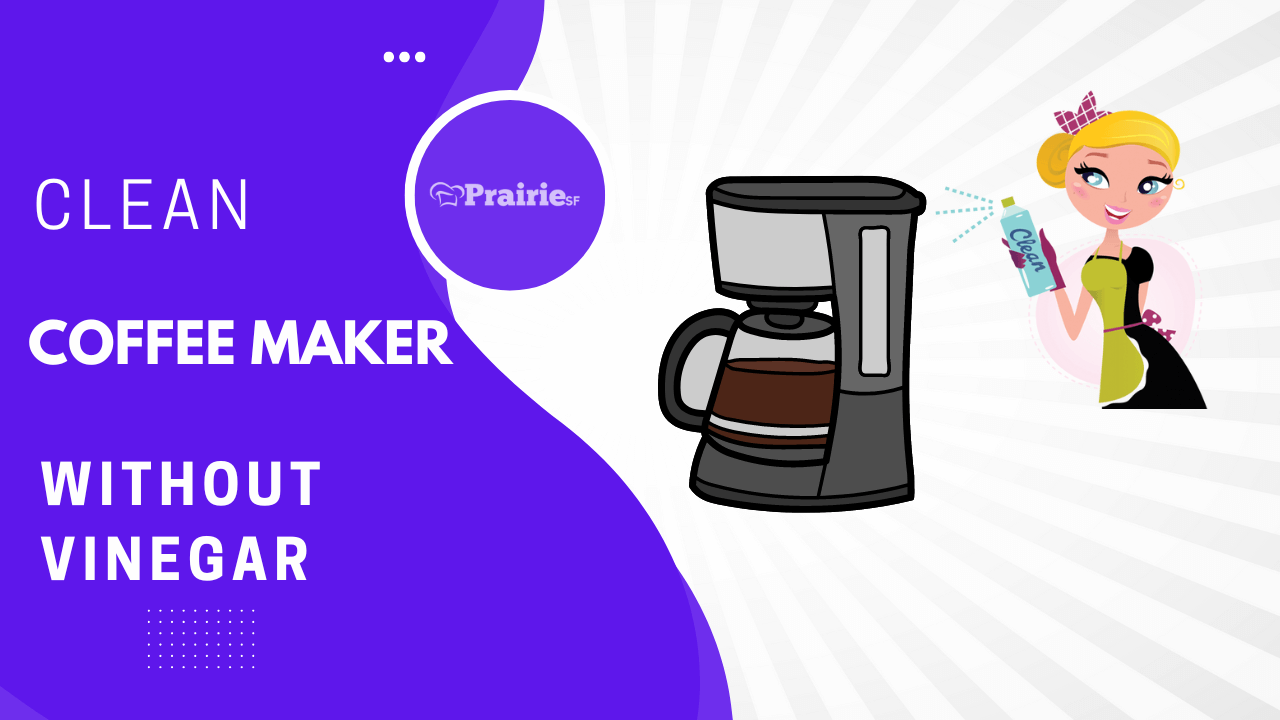If you are someone who loves a freshly brewed cup of coffee, you are likely to be disappointed if your coffee smells weird. For cleaning purposes, vinegar is one of the most commonly opted supplies. It works as an easy supply to get rid of the troublesome dust and dirt from the surface of your coffee machine. However, if you use vinegar to clean your coffee machine, there are strong chances that it will leave a vinegar scent. And if that scent comes into your cup of coffee, you are likely to be put off. This necessitates the need to think of alternatives to vinegar that are equally effective but don’t leave off an odor.

If you are someone who can’t start your day without coffee, you will need a good cleaning routine and for that, you will also need to arrange cleaning supplies that will work similarly to vinegar. Following are the 5 best substitutes for cleaning coffee makers. The ones that have been mentioned below include lemon juice, soap and warm water solution, borax, baking soda, and hydrogen peroxide. You can opt for any one of them depending upon your choice. The only similarity is that all of these materials are usually easily available.
Contents
The 5 Best Substitutes To Clean Coffee Maker Without Vinegar
-
Lemon Juice
Use lemon juice to enjoy the cleaning power of vinegar. Since it contains citric acid, lemon juice works in a manner identical to that of vinegar which contains acetic acid. Now, the process to clean a coffee maker with lemon juice is similar to the one carried out using vinegar.
In your reservoir, pour one part water with one part lemon juice. Now allow it to run in your coffee maker on a regular brew cycle. In case your coffee maker has a heavy limescale buildup, make sure you run lemon juice through your coffee maker.
Once you’ve run lemon juice through your machine, follow it with one or two cycles of pure distilled water. This will help get rid of any traces of lemon juice left in the coffee maker.
Since lime juice has acidic properties, it helps to get rid of limescale buildup. At the same time, it offers an uplifting and pleasant scent. You can even pour one part lemon juice and one part water into a bottle spray and use it on the exterior of the coffee maker.
If you plan on routinely cleaning your coffee maker, run the lemon juice through the machine once or twice a month.
-
Soap And Warm Water Solution
Sometimes, a good soapy solution is sufficient to clean your coffee maker. Using a soapy rub on your lid, filter, and carafe will enable you to get rid of any coffee buildup. In order to make this method effective, you need to clean your coffee maker on a regular basis.
If you allow your coffee brew to remain in the coffee maker for a long period of time, it will be harder to clean the machine. You can make the cleaning process easier by using the dishwasher to clean your carafe. Note that not every removable part of your coffee maker is dishwasher safe unless specified in the manual.
To avoid the occurrence of buildup, you can even run one or two cycles of pure distilled water through your brewing machine once every three or four days. This will make sure that your coffee machine performs well and at the same time, emits a desirable odor.
Using soap and warm water solution to clean your coffee machine like your French Press does wonders. All the mineral residue and stuck-on particles on/in your coffee machine will be easily removed without much effort.
-
Borax
If you want to descale your coffee machine, you can substitute vinegar with borax. Sodium borate is a colorless and soft powder that is soluble in water. Borax functions as a great cleaning supply particularly if you want to get rid of mildew and mold. In addition, borax doesn’t leave off a chemical residue.
You can easily use borax to clean your coffee machine because it neutralizes hard water. At the same time, it helps to get rid of any bad or unwanted odors in your coffee machine.
The procedure to clean your coffee machine using borax is relatively simple and does wonders when you wish to clean coffee machines such as Keurigs. Pour distilled water into the reservoir of your coffee maker. Now put 2 tablespoons of borax in the machine and run it on a regular brew cycle. When the borax runs through the machine, it will perform the same function performed by vinegar. However, it won’t leave behind a pungent odor as vinegar does.
When this cycle is complete, make use of distilled water to run 3-4 cycles to remove the traces of borax. Note that this method might be slightly tiresome because you will have to repeat the brewing cycle about 3 or 4 times. However, these results will be worth the hectic process and what’s more, you will only have to carry out this process once every month.
-
Baking Soda
Baking soda functions in a way similar to that of Borax. It enables you to descale your coffee maker. Baking soda is a versatile as well as a powerful tool to perform cleaning functions. Now the process of using baking soda is a straightforward one.
Mix ¼ cup of baking soda with one cup of warm water. Put this mixture in a reservoir and then run a full cycle on your coffee maker.
When this cycle is complete, make sure you run another one using pure distilled water. This mixture can be easily used both inside your coffee machine as well as on the exteriors.
Note that baking soda is a non-toxic material that makes use of natural ingredients to clean your coffee machine. It is easy to use and effective as well.
-
Hydrogen Peroxide
Although hydrogen peroxide is widely used as a medical disinfectant, this property can be effectively utilized on various kitchen appliances as well. The primary function of hydrogen peroxide is to kill bacterial buildup. Another function of hydrogen peroxide is to remove unwanted odors from your cooking machine.
To do this, mix two parts of warm distilled water with one part of hydrogen peroxide. Now start a regular cycle on your coffee machine after you put this solution in the reservoir. This solution will kill any germs or bacteria that have been lingering on the surface of your machine. If your coffee machine has a comparatively harder buildup, you can run a second cycle of hydrogen peroxide.
Once you’re finished running cycles of hydrogen peroxide, brew two to three cycles using pure distilled water. Moreover, run a cycle using lemon juice if you feel that there are some unwanted odors lurking in your coffee machine. Although hydrogen peroxide emits no odor, you may experience a slight odor as a result of heavy mineral buildup.
You can even use hydrogen peroxide to clean the outer surface of your coffee machine. Just make sure that you later clear the surface using pure distilled water. Hydrogen peroxide is a powerful disinfectant that works similarly to vinegar. It is a particularly effective way to clean the limescale and at the same time, disinfect your coffee machine.
Conclusion
Although vinegar is one of the most powerful cleaning tools, it is not the only one. The odor left behind by vinegar can be a turn-off for some people. Furthermore, not many people have vinegar just lying in their houses for the purpose of descaling and disinfecting the coffee makers. However, who would not want to clean their brewing machine?
Well, no one. We all want to enjoy a freshly brewed cup of coffee, especially during the morning hours and the unavailability of vinegar should not stop you from cleaning your coffee machine.
Therefore, luckily enough, there are several alternatives to vinegar including borax, lemon juice, soap and warm water solution, baking soda, and hydrogen peroxide. Borax does wonders particularly if you want to properly clean your coffee machine and get rid of mold and mildew. Lemon juice performs a function similar to the one performed by vinegar.
The only difference is that it doesn’t leave behind a pungent odor. Soap and warm water solutions allow users to clean all forms of dust and dirt on or inside the coffee machine without causing any harm to the coffee maker. Baking soda removes any dirt or mineral residue that it finds on the surface of the coffee machine. Lastly, hydrogen peroxide lets go of the undesired odors from the coffee machine.
Note that if you’d rather clean the removable parts of your coffee machine in a dishwasher, it is only the carafe that is dishwasher safe. All the other parts need to be cleaned manually.
Therefore, depending on the availability of supplies, you can opt for any of the above-mentioned substitutes and follow the associated steps to effectively clean your coffee machine. Clean your coffee machine and enjoy yourself with a freshly brewed cup of coffee.

